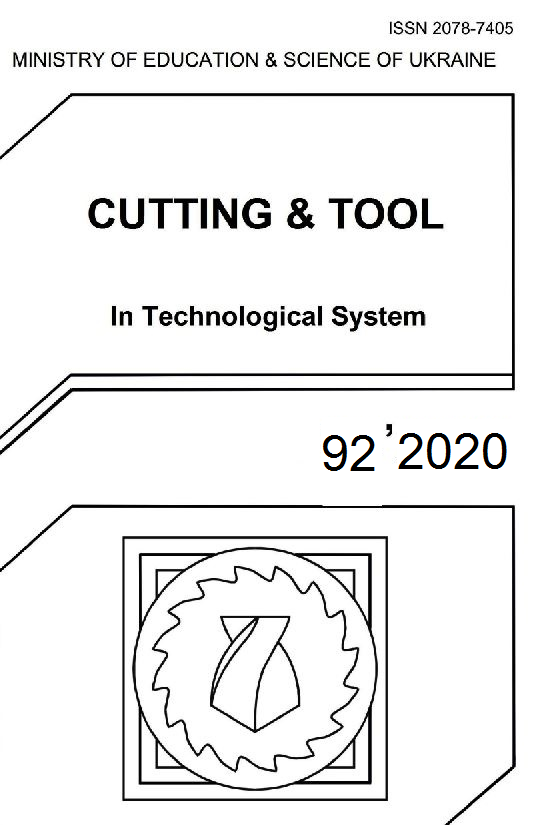STRENGTHENING OF THE SURFACE LAYER OF THE WELD PARTS WHEN TURNING BY CUTTERS WITH PSTM “KIBORIT”
DOI:
https://doi.org/10.20998/2078-7405.2020.92.25Keywords:
welded metal, turning modes, tool with PCBN «cibоrite», hardened surface layer, microhardness.Abstract
The results of an experimental study of hardening of the surface layer of parts deposited by electric arc welding with Np-30KhGSA wire under a flux layer of AN-348A are presented, when machined with cutters equipped with replaceable non-milling plates RNMN 070300 made of polycrystalline superhard material (PCBN) based on cubic boron nitride «ciborite». The influence of mining regimes on the surface microhardness and the thickness of the hardened surface layer of parts is studied. The nature of the lines of equal microhardness indicates a less significant effect of the cutting speed compared to the depth of cut and feed and a close degree of influence of changes in the latter. Processing speeds have less effect on the thickness of the hardened layer compared to the depth of cut and the amount of feed, although the latter has a less intense effect. The greatest hardening of the deposited parts was achieved by turning with a cutter with rake angles of (40–50)°. Treatment with chisels with PCBN «ciborite» with large negative values of the front angle γ is accompanied by the creation in the processing area of such a level of thermobaric load, which leads to structural changes in the surface layer of parts, namely, a layer of weakly etchable hardening structure – unstructured martensite H50 = 5700–5920 MPa, which is 1.8–2.1 times higher than the microhardness of the main weld material. The thickness of the reinforced deposited layer during blade-hardening processing with a tool with PCBN «ciborite» is 60–80 μm, due to the low carbon content in the material, the presence of ascending diffusion of carbon and intense plastic deformation in the contact zone. The results show that blade-hardening machining with tools with PCBN is an effective method of controlling the performance of machine parts, such as their wear resistance.References
Karpenko V. G. et all. Uprochneniye stali mekhanicheskoy obrabotkoy. Kyiv, Naukova dumka Publ., 1966, 204 p.;
Sulima A. M., Shulov V. A., Yagodkin Yu. D. Poverkhnostnyy sloy i ekspluatatsionnyye svoystva detaley mashin. Moskow, Mashinostroyeniye Publ., 1988, 239 p.;
Chizhik S. A. et all. Obespecheniye kachestva izdeliy v tekhnologicheskikh kompleksakh. Minsk, Belaruska navuka Publ, 2019, 248 p.;
Klimenko S. A. et all. Vysokoproizvoditel'naya chistovaya lezviynaya obrabotka detaley iz staley vysokoy tverdosti. – Kyiv, ISM im. V. N. Bakulya NAN Ukrainy Publ., 2018, 304 p.;
Ryzhov E. V., Klimenko S. A., Gutsalenko O. G. Tekhnologicheskoye obespecheniye kachestva detaley s pokrytiyami. Kyiv, Naukova dumka Publ., 1994, 176 p.;
Novikov N. V. (ed.). Sverhtverdye materialy. Poluchenie i primenenie: v 6-i т. T. 5. Klimenko S. A. et all. Obrabotka rezaniyem detaley s pokrytiyami. – Kyiv, ISM im. V. N. Bakulya NAN Ukrainy Publ., 353 p.;
Putyatina L. I. Lezovo-zmítsnyuval'na mekhaníchna obrobka detaley z visokomítsnogo chavunu ínstrumentom z tverdogo splavu ta NTM: Avtoref. diss. kand. techn. nauk. Kyiv, 2004, 19 p.;
Klimenko S. A. et all. Obrabotka materialov lezviynym instrumentom. – Kyiv, ISM im. V. N. Bakulya, IPTS «ALKON» NANU Publ, 2006, 316 p.;
Kolomiyets V. V. et all. Vliyaniye mekhanicheskoy obrabotki na svoystva poverkhnostnogo sloya naplavlennykh detaley. Tr. 8-y Mezhdunar. nauch.-tekhn. konf. «Fizicheskiye i komp'yuternyye tekhnologii». Kharkiv, 2003, pp. 61–63.
Downloads
Published
Issue
Section
License
Copyright Notice
Authors who publish with this Collection agree to the following terms:
1. Authors retain copyright and grant the Collection right of first publication with the work simultaneously licensed under a Creative Commons Attribution License that allows others to share the work with an acknowledgement of the work's authorship and initial publication in this Collection.
2. Authors are able to enter into separate, additional contractual arrangements for the non-exclusive distribution of the Collection's published version of the work (e.g., post it to an institutional repository or publish it in a book), with an acknowledgement of its initial publication in this Collection.
3. Authors are permitted and encouraged to post their work online (e.g., in institutional repositories or on their website) prior to and during the submission process, as it can lead to productive exchanges, as well as earlier and greater citation of published work.

